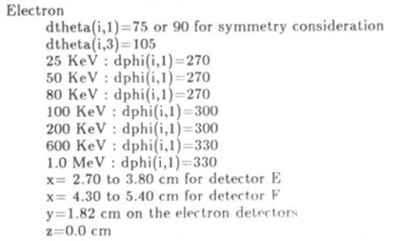The Galileo Energetic Particles Detector
Galileo EPD Handbook
Chapter 1. Instrument Summary
Numerical Calculation of Three-Dimensional Electron and Proton Trajectories in the Galileo EPD LEMMS Sensor Assembly (continued)
Appendix C The Computer Program (continued)
The Input Parameters
The input parameters are given below. For a given position and energy of the particle, the scanning process starts from the middle of the azimuthal angles among which there are possible escaping trajectories. The limits on the polar angles are determined by the geometry of the sensor. The intervals of the angles can be decided by the user. However, a very short time interval can lead to substantial consumption of CPU time. The user is cautioned in adjusting this parameter. Time parameters are important, and both the ending time and interval time should be negative because this is time reversal calculation. The magnitude of the ending time can be very long since the program will stop trajectory calculation when the particle hits the boundary surfaces or goes beyond the outer aperture (at x=0.225 cm). The description of the input parameters and a sample of the parameters are listed below.
In order to reduce computer time, several simplifications can be made based on the symmetry of the system. The sample points away from the middle plane only need to be explored at one side since the other side is just the image. The angular distributions of the particle with the scanning positions on the middle plane have polar angle symmetry; therefore the scanning polar angles for these positions can start from the middle plane and recover the other side data later.
Description of the input parameters

Sample of the input parameters (units for angles: degree)


Next: Common Blocks
Return to Galileo EPD Handbook Table of Contents Page.
Return to main
Galileo Table of Contents Page.
Return to Fundamental
Technologies Home Page.
Updated 8/23/19, Cameron Crane
QUICK FACTS
Mission Duration: Galileo was planned to have a mission duration of around 8 years, but was kept in operation for 13 years, 11 months, and 3 days, until it was destroyed in a controlled impact with Jupiter on September 21, 2003.
Destination: Galileo's destination was Jupiter and its moons, which it orbitted for 7 years, 9 months, and 13 days.



